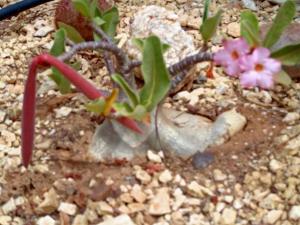The genus name Aloe is derived from the Arabic, alloch and translated as allal in Greek and Hebrew, literally meaning bitter or bitter sap which is descriptive of Aloe sap. The genus Aloe belong to the family Asphodelaceae to which also other succulent genera such as Haworthia and Gasteria. A widely spread misunderstanding is that also the Agave and related American genera belong to the same famly. These belong to the family of the Agavaceae. Some Aloe species (f.e. A. Ferox, A. Barbados and A. Socotrine) are valued for their medical properties. There is however a large number of medical claims which are not scientifically proven up to date or are proven to be false. The globally best known Aloe is the Aloe barbadensis (better known under the previous botanical name Aloe vera). The Aloe barbadensis is commercially cultivated in the USA, Australia and India. In Maharashtra, Madhya Pradesh, and Gujarat, India, Aloe vera is raised as an organic. The crop is ready for harvest after 18 months from sowing. The average yield for organically grown aloe is approximately 12 t/ha.
Soil
A slightly alkaline (up to pH 8.5) sandy loam soil is the most ideal for most Aloes but some prefer slight acidic soil (pH 5.5-6.5) such as A. mitriformis (A. perfoliata) and A. plicatilis. It is normally propagated through root suckers or by cuttings of the new growth. Because Aloe plants consist of 95% water, they are extremely frost tender. If they are grown outdoors in warm climates, they should be planted in full sun, or light shade. The soil should be moderately fertile, and fast draining. Established plants will survive a drought quite well, but for the benefit of the plant, water should be provided.
Pests:
All known garden pests can be kept to a minimum by simply ensuring optimal growing conditions and a good selection of plants that attract wildlife to your garden. In principle a garden is always un-natural. One of the challenges of organic gardening is to make use of nature in order to strive towards an ecological balance. For our and your dissapointment: even nature is never in balance. There are many ‘surprises’ every year but without ‘ecological measurements’ these can go a bit out of control. A daily ‘inspection’ walk in the garden -preferable early morning or late afternoon- helps the gardener to foresee ‘threatening’ pests and diseases and making the right decisions towards preventive measurements.
Most common pests/diseases in aloes are aphids, scale insects and cancer.
For scale insects the best results are obtained by physically removing scale using a cloth.
Occasional aphids on flower clusters and scale insects on leaves. These are relatively easy to control with water (high pressure) of, even better, preventive with a tea of garlic. Aphids are ‘farmed’ by ants. The ants regard aphids as their ‘milk cows’. Keeping ants away, two rings (10 cm or 4 inches space between them) of chalk powder on soil around aloes, minimalise the number of ants and aphids.
Cancer: Caused by aloe-cancer mite. This mite lives inside the plant and is the carrier of the virus and cause the cells to multiply and form ugly weird growths. Cut out the affected part of the plant and let it dry. General info about pest control and pest and disease prevention can be read elsewhere in this blog
Propagating
Propagating is best done via cuttings. Sowing is also possible but bear in mind that Aloes hybridize easily.
Southern Africa is home to a few hundred Aloe species. Two of our favorites are the Aloe perfoliata and the Aloe polyphylla.
Aloe perfoliata
Growing A. perfoliata is very easy. The best results are achieved by simply making stem cuttings. Allow cuttings to dry for a few days and insert into river sand and keep moist. The roots appear after about two weeks. Seeds must be sown as fresh as possible. When kept too long they are parasitized by small crawling insects. The best time for sowing would be in the winter, June to July. Use coarse river sand and cover seeds lightly, then keep moist. It is advisable to treat seeds with a tea of khaki-bush, as seedlings are prone to damping off, a fungus that eventually kills the young plants. Simply add tea to the soil. After germination, when plants are about 20 to 30 mm, plant over using a sandy-loam medium. If you have a garden with clay soil, use some bone meal to break up and nourish the soil. Mature plants in the garden may from time to time be subjected to attack from scale insects and aphids.
Aloe polyphylla originates from high, relatively cold, altitudes in Lesotho. It is a very difficult plant to cultivate in the open in the Western Cape. It’s main requirement is well-drained soil. It performs best when planted on a slope (or planted up at a slight angle so water does not collect in the spiral), where it can enjoy sun, or part (afternoon-) shade in the hottest areas. It also does well in pots. Water requirements depend on soil and weather. They are generally suited to low water, but prosper with some summer water.
Information about South African Aloe species can be obtained via one of the websites of the National Biodiversity Institute. This site contains a wealth of info of many indigenous plants including succulents.




